Popular categories
Looking for a yarn?

100% Cotton
from 1.85 £ /50g
Order DROPS Muskat from Wool Warehouse Direct Ltd

|
DROPS Muskat uni colour 100% Cotton |
1.85 £ /50g |
Order |
Clicking the ORDER button will redirect you to Wool Warehouse Direct Ltd website
Order DROPS Needles & Hooks
Clicking the ORDER button will redirect you to Wool Warehouse Direct Ltd website
The yarn cost is calculated from the pattern’s smallest size and the yarn’s cheapest product type. Looking for an even better price? You might find it on the DROPS Deals!
DROPS 78-11
DROPS Cardigan in Muskat
Sizes: S - M - L - XL - XXL
Finished measurements: 88-96-102-108-122 cm
Materials: DROPS MUSKAT from Garnstudio
450-500-550-600-650 gr nr 22, brown.
7 DROPS shell buttons, nr 525
DROPS 4 mm circular and double-pointed needles, or size needed to obtain correct gauge.
-------------------------------------------------------
Alternative Yarn – See how to change yarns here
Yarn Groups A to F – Use the same pattern and change the yarn here
Yarn usage using an alternative yarn – Use our yarn converter here
-------------------------------------------------------
Women Jackets & Cardigansbottom up cable lace sewn in sleeves stocking stitch v-neck

100% Cotton
from 1.85 £ /50g
Order DROPS Muskat from Wool Warehouse Direct Ltd

|
DROPS Muskat uni colour 100% Cotton 1.85 £ /50g Order |
Clicking the ORDER button will redirect you to Wool Warehouse Direct Ltd website
Order DROPS Needles & Hooks
Clicking the ORDER button will redirect you to Wool Warehouse Direct Ltd website
The yarn cost is calculated from the pattern’s smallest size and the yarn’s cheapest product type. Looking for an even better price? You might find it on the DROPS Deals!
- English (UK/cm)
- Česky - not translated
- Dansk
- Deutsch
- Eesti keel
- English (US/in)
- Español
- Français
- Íslenska - not translated
- Italiano - not translated
- Magyar
- Nederlands
- Norsk
- Polski
- Português
- Suomi
- Svenska
- English (UK/cm), Bulgaria
- English (UK/cm), Croatia
- English (UK/cm), Greece
- English (UK/cm), Latvia
- English (UK/cm), Lithuania
- English (UK/cm), Romania
- English (UK/cm), Slovenia
- Česky, Slovakia - not translated
Pattern instructions
Pattern: See chart. The pattern is seen from the right side.
Garter st, when knitting flat: Knit all sts, all rows.
Buttonhole: Make buttonholes along right button band. Make buttonholes as follows (right side row): 2 sts garter st, K 2 tog, yo, P 3. On the next row (wrong side) P the yo from previous row.
Make buttonholes when the piece measures:
Size S: 2, 7, 11, 16, 21, 25 and 30 cm.
Size M: 2, 7, 12, 17, 22, 27 and 31 cm.
Size L: 2, 7, 12, 17, 22, 27 and 32 cm.
Size XL: 2, 7, 12, 18, 23, 28 and 33 cm.
Size XXL: 2, 8, 13, 19, 24, 29 and 34 cm.
Knitting tips (for neckband):
All decs are made from right side. Dec 1 st for the neck every other row inside 7 buttonband sts as follows:
After 7 buttonband sts: Sl 1 as if to knit, K 1, psso.
Before 7 buttonband sts: K 2 tog.
Body: Cast on 200-214-228-242-270 sts and establish pattern as follows on first row (right side row): K 2 (edge sts knit in garter st throughout), K 2, P 3 (5 sts in rib) – these 7 sts are the buttonband, Pattern 1 over 186-200-214-228-256 sts, P 3, K 2 (5 sts in rib), K 2 (edge sts knit in garter st throughout) – these 7 sts are the buttonband. Continue in pattern as established. Make buttonholes along right buttonband - see instructions above.
When the piece measures 20 cm knit stockinette st to finished measurements, keeping the 7 sts at each side (buttonbands) the same as before. When the piece measures 31-32-33-34-35 cm knit the next row as follows (right side row): 50-54-57-61-68 sts (= right front), bind off 6 sts for armhole, 88-94-102-108-122 sts (= back), bind off 6 sts for armhole, 50-54-57-61-68 sts (= left front). Knit each piece separately.
Left front: = 50-54-57-61-68 sts. Bind off at the same time for armhole and V-neck.
Armhole: Bind off for armhole at the side every other row: 3 sts 0-1-1-2-2 times, 2 sts 1-1-2-2-4 times and 1 st 3-2-3-3-5 times.
V-neck: At the same time dec 1 st for the neck every other row inside the 7 buttonband sts 19-20-19-20-20 times - see knitting tips.
After all armhole and neck shaping is complete 26-27-28-28-29 sts remain on shoulder. Bind off when the piece measures 50-52-54-56-58 cm.
Right front: = 50-54-57-61-68 sts. Knit the same as left front, reversing shaping and continuing to make buttonholes.
Back: = 88-94-102-108-122 sts. Bind off for armhole at each side as on front = 78-80-82-82-84 sts remain. When the piece measures 47-49-51-53-55 cm knit rib as follows over the center 40 sts: P 3, * K 2, P 2 *, repeat from * - *, finish with K 2, P 3 (knit the remaining sts in stockinette st). When the piece measures 49-51-53-55-57 cm bind off the center 26 sts in rib. Keep the 7 sts at each neck edge in rib as follows (seen from right side): K 2 (edge sts knit in garter st), K 2 and P 3. Bind off all sts when the piece measures 50-52-54-56-58 cm.
Sleeve: Cast on 56-56-56-63-63 sts on double-pointed needles; join and place a marker at the join. Knit 1 row with K 1, P 1 rib, then knit stockinette st. When the piece measures 9 cm knit Pattern 1. When the piece measures 18 cm knit stockinette st to finished measurements. After Pattern 1 inc 1 st each side of marker every 4-3-2.5-2.5-2 cm a total of 8-10-12-11-13 times = 72-76-80-85-89 sts.
When the piece measures 50-49-48-47-44 cm bind off 3 sts each side of marker. Then bind off for sleeve cap at each side every other row: 3 sts 1 time, 2 sts 3-3-3-3-2 times, 1 st 1-4-4-5-12 times, then bind off 2 sts at each side until the piece measures 57 cm, then bind off 3 sts at each side 1 time. The piece measures approx. 58 cm, bind off.
Assembly: Sew shoulder seams and sew in sleeves and buttons.
Diagram

|
= knit on RS, purl on WS |

|
= purl on RS, knit on WS |

|
= yo |

|
= K 2 tog |

|
= Slip 1 as if to knit, K 1, psso |
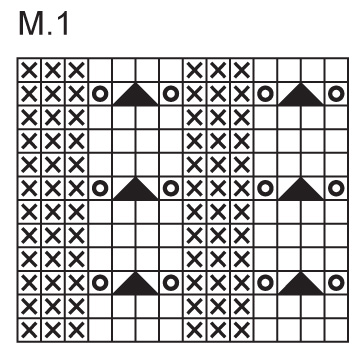
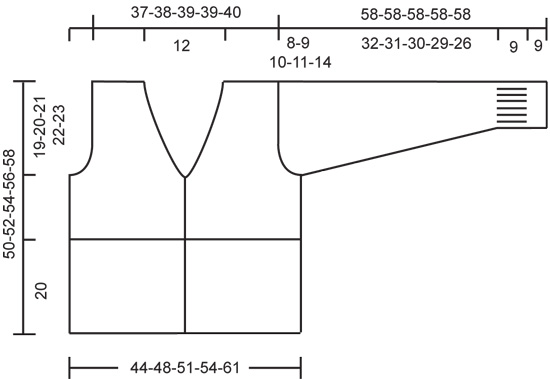
What can you do with our patterns? You can share DROPS patterns online, using the pattern original picture, materials, name and number. But you are NOT ALLOWED to reproduce the complete pattern digitally in any way. Yarn stores are welcome to use the DROPS pattern database to promote the sale of our assortment. You can print out our patterns, make as many copies as you’d like. The only thing we ask is that you don't make any changes / additions to the original printed document. And that the patterns according to the DROPS philosophy are given out to the consumers for free. Editorials that wish to publish our patterns in printed books or magazines can contact us for more information. The sale of garments based on DROPS patterns is permitted as long as they are sold as single items or per order. Further commercial use of the patterns is not permitted. It has to be clearly stated that the garment is made based on a design from DROPS DESIGN. The use of clothing labels of which DROPS DESIGN forms part is conditioned by the inclusion of the following text: “A DROPS DESIGN made by …..”. The use of DROPS photos for marketing purposes/sales is only permitted in connection with the use/sale of DROPS products. The photos may not be cut or edited and the logo should be clearly visible.
We reserve the right to withdraw the permission for use of our patterns at any time, notwithstanding the reason.
Each of our patterns has specific tutorial videos to help you.
These step-by-step tutorials might also help you:
Why is the knitting/crochet tension so important?
Knitting tension is what determines the final measurements of your work, and is usually measured per 10 x 10 cm. It is provided like so: number of stitches in width x number of rows in height - eg: 19 stitches x 26 rows = 10 x 10 cm.
The knitting tension is very individual; some people knit/crochet loosely while others work tightly. You adjust the knitting tension with the needle size, which is why the suggested needle size is only meant as a guide! You need to adjust this (up or down) to ensure that YOUR knitting tension matches the knitting tension provided in the pattern. If you work with a different knitting tension than provided you will have a different yarn consumption, and your work will have different measurements than what the pattern suggests.
The knitting tension also determines which yarns can replace each other. As long as you achieve the same knitting tension you can replace one yarn with another.
See DROPS lesson: How to measure your tension/gauge
See DROPS video: How to make a gauge tension swatch
How do I know how many balls of yarn I need?
The required amount of yarn is provided in grams, eg: 450 g. To calculate how many balls you’ll need you first need to know how many grams are in 1 ball (25g, 50g or 100g). This information is available if you click on the individual yarn quality on our pages. Divide the amount required with the amount of each ball. For example, if each ball is 50g (the most common amount), the calculation will be as follows: 450 / 50 = 9 balls.
Can I use a different yarn than what the pattern suggests?
The important thing when changing from one yarn to another is that the knitting/crochet tension remains the same. This is so that the measurements of the finished piece will be the same as on the sketch provided. It is easier to achieve the same knitting tension using yarns from the same yarn group. It is also possible to work with multiple strands of a thinner yarn to achieve the knitting tension of a thicker one. Please try our yarn converter. We recommend you to always work a test swatch.
Please NOTE: when changing yarn the garment might have a different look and feel to the garment in the photo, due to individual properties and qualities of each yarn.
See DROPS lesson: Can I use a different yarn than the one mentioned in the pattern?
What are the yarn groups?
All our yarns are categorised into yarn groups (from A to F) according to thickness and knitting tension – group A contains the thinnest yarns and group F the thickest. This makes it easier for you to find alternative yarns to our patterns, should you wish to switch yarn. All yarns within the same group have a similar knitting tension and can easily replace each other. However, different yarn qualities have different structures and properties which will give the finished work a unique look and feel.
How do I use the yarn calculator?
At the top of all our patterns you’ll find a link to our yarn calculator, which is a helpful tool should you wish to use a different yarn than suggested. By filling in the yarn quality you wish to replace, the amount (in your size) and number of strands, the calculator will present good alternative yarns with the same knitting tension. Additionally it will tell you how much you’ll require in the new qualities and whether you’ll need to work with multiple strands. Most skeins are 50g (some are 25g or 100g).
If the pattern is worked with multiple colours, every colour will have to be calculated separately. Similarly, if the pattern is worked with several strands of different yarns (for example 1 strand Alpaca and 1 strand Kid-Silk) you will have to find alternatives for each, individually.
Why do you show discontinued yarns in the patterns?
Since different yarns have different qualities and textures we have chosen to keep the original yarn in our patterns. However, you can easily find options among our available qualities by using our yarn calculator, or simply pick a yarn from the same yarn group.
It is possible that some retailers still have discontinued yarns in stock, or that someone has a few skeins at home that they would like to find patterns for.
The yarn calculator will provide both alternative yarn as well as required amount in the new quality.
What size should I knit?
If you think it's hard to decide what size to make, it can be a good idea to measure a garment you own already and like the size of. Then you can pick the size by comparing those measures with the ones available in the pattern's size chart.
You'll find the size chart at the bottom of the pattern.
See DROPS lesson: How to read size chart
Why do I get the wrong knitting tension with the suggested needle size?
The needle size provided in the pattern serves only as a guide, the important thing is to follow the knitting tension. And since knitting tension is very individual, you will have to adjust the needle size to ensure that YOUR tension is the same as in the pattern – maybe you’ll have to adjust 1, or even 2 needle sizes, up or down to achieve the correct tension. For this, we recommend that you work test swatches.
Should you work with a different knitting tension than the one provided, the measurements of the finished garment might deviate from the measurement sketch.
See DROPS lesson: How to measure your tension/gauge
See DROPS video: How to make a tension/gauge swatch
Why is the pattern worked top-down?
Working a garment top-down provides more flexibility and room for personal adjustment. For example it is easier to try the garment on while working, as well as making adjustments to length of yoke and shoulder caps.
The instructions are carefully explaining every step, in the correct order. Diagrams are adjusted to the knitting direction and are worked as usual.
How do I work according to a knitting diagram?
The diagram depicts all rows/rounds, and every stitch seen from the right side. It is read from bottom to top, from right to left. 1 square = 1 stitch.
When working back and forth, every other row is worked from the right side and every other row is worked from the wrong side. When working from the wrong side, the diagram will have to be worked reversed: from left to right, knit stitches are purled, purl stitches are knit etc.
When working in the round every round is worked from the right side and the diagram are worked from right to left on all rounds.
See DROPS lesson: How to read knitting diagrams
How do I work according to a crochet diagram?
The diagram depicts all rows/rounds, and every stitch seen from the right side. It is worked from bottom to top, from right to left.
When working back and forth every other row is worked from the right side: from right to left and every other row is worked from the wrong side: from left to right.
When working in the round, every row in the diagram are worked from the right side, from right to left.
When working a circular diagram you start in the middle and work your way outwards, counter clockwise, row by row.
The rows usually start with a given number of chain stitches (equivalent to the height of the following stitch), this will either be depicted in the diagram or explained in the pattern.
See DROPS lesson: How to read crochet diagrams
How do I work several diagrams simultaneously on the same row/round?
Instructions for working several diagrams after each other on the same row/round, will often be written like so: “work A.1, A.2, A.3 a total of 0-0-2-3-4 times". This means you work A.1 once, then A.2 is worked once, and A.3 is repeated (in width) the number of times provided for your size – in this case like so: S = 0 times, M = 0 times, L=2 times, XL= 3 times and XXL = 4 times.
The diagrams are worked as usual: begin with the first row in A.1, then work the first row in A.2 etc.
See DROPS lesson: How to read knitting diagrams
See DROPS lesson: How to read crochet diagrams
Why are the sleeves shorter in larger sizes?
The total width of the garment (from wrist-to-wrist) will be larger in the larger sizes, despite the actual sleeves being shorter. The larger sizes have longer sleeve caps and wider shoulders, so there will be a good fit in all sizes.
Where on the garment is the length measured?
The measurement sketch/schematic drawing provides information regarding the full length of the garment. If it’s a jumper or a jacket the length is measured from the highest point on the shoulder closest to the neckline, and straight down to the bottom of the garment. It is NOT measured from the tip of shoulder. Similarly, the length of yoke is measured from the highest point on the shoulder and down to where yoke is split into body and sleeves.
On a jacket measures are never taken along bands, unless specifically stated. Always measure inside band stitches when measuring the length.
See DROPS lesson: How to read a schematic drawing
What is a repeat?
Diagrams are often repeated on the round or in height. 1 repeat is the diagram the way it appears in the pattern. If it says to work 5 repeats of A.1 in the round, then you work A.1 a total of 5 times after/next to each other in the round. If it says to work 2 repeats of A.1 vertically/in height you work the entire diagram once, then begin again at the start and work the entire diagram one more time.
Why does the piece start with more chain stitches than it’s worked with?
Chain stitches are slightly narrower than other stitches and to avoid working the cast-on edge too tight, we simply chain more stitches to begin with. The stitch count will be adjusted on the following row to fit the pattern and measurement sketch.
Why increase before the rib edge when the piece is worked top-down?
The rib edge is more elastic and will contract slightly compared to, for example, stocking stitch. By increasing before the rib edge, you avoid a visible difference in width between the rib edge and the rest of the body.
Why increase in the cast-off edge?
It’s very easy to cast off too tightly, and by making yarn overs while casting off (and simultaneously casting these off) you avoid a too tight cast off edge.
See DROPS video: How to bind off with yarn overs (yo)
How do I increase/decrease on every 3rd and 4th row/round alternately?
To achieve an even increase (or decrease) you can increase on, for example: every 3rd and 4th row alternately, like so: work 2 rows and increase on the 3rd row, work 3 rows and increase on the 4th. Repeat this until the increase is complete.
See DROPS lesson: Increase or decrease 1 st on every 3rd and 4th row alternately
How can I work a jacket in the round instead of back and forth?
Should you prefer to work in the round instead of back and forth, you may of course adjust the pattern. You’ll need to add steeks mid-front (usually 5 stitches), and follow the instructions. When you would normally turn and work from the wrong side, simply work across the steek and continue in the round. At the end you’ll cut the piece open, pick up stitches to work bands, and cover the cut edges.
See DROPS video: How to knit steeks and cut open
Can I work a jumper back and forth instead of in the round?
Should you prefer to work back and forth instead of in the round, you may of course adjust the pattern so you work the pieces separately and then assemble them at the end. Divide the stitches for the body in 2, add 1 edge stitch in each side (for sewing) and work the front and back pieces separately.
See DROPS lesson: Can I adapt a pattern for circular needles into straight needles?
Why is the pattern slightly different than what I see in the photo?
Pattern repeats can vary slightly in the different sizes, in order to get the correct proportions. If you’re not working the exact same size as the garment in the photo, yours might deviate slightly. This has been carefully developed and adjusted so that the complete impression of the garment is the same in all sizes.
Make sure to follow instructions and diagrams for your size!
How do I make a women’s size garment into a men’s size one?
If you have found a pattern you like which is available in women’s size it’s not very difficult to convert it to men’s size. The biggest difference will be the length of sleeves and body. Start working on the women size that you think would fit across the chest. The additional length will be worked right before you cast off for the armhole/sleeve cap. If the pattern is worked top-down you can add the length right after the armhole or before the first decrease on sleeve.
Regarding additional yarn amount, this will depend on how much length you add, but it is better with a skein too many than too few.
How do I prevent a hairy garment from shedding?
All yarns will have excess fibres (from production) that might come off as lint or shedding. Brushed yarns (ie hairier yarns) have more of these loose, excess fibres, causing more shedding.
Shedding also depends on what is worn under or over the garment, and whether this pulls at the yarn fibres. It’s therefore not possible to guarantee that there will be no shedding
Below are some tips on how to get the best result when working with hairier yarns:
1. When the garment is finished (before you wash it) shake it vigorously so the looser hairs come off. NOTE: do NOT use a lint roller, brush or any method that pulls at the yarn.
2. Place the garment in a plastic bag and put it in your freezer - the temperature will cause the fibres to become less attached to each other, and excess fibres will come off easier.
3. Leave in the freezer for a few hours before taking it out and shaking it again.
4. Wash the garment according to the instructions on the yarn label.
Why does my garment pill?
Pilling is a natural process that happens to even the most exclusive of fibers. It's a natural sign of wear and tear that is hard to avoid, and that is most visible in high friction areas of your garment like a sweater's arms and cuffs.
You can make your garment look as new by removing the pilling, using a fabric comb or a pill/lint remover.
In the meantime, you can read the questions and answers that others have left to this pattern or join the DROPS Workshop on Facebook to get help from fellow knitters/crocheters!
You might also like...
DROPS 78-11 |
||||||||||||||||
|
|
||||||||||||||||
DROPS Cardigan in Muskat
DROPS 78-11 |
||||||||||||||||
|
Gauge: 21 sts x 28 rows = 10 x 10 cm in stockinette st. Pattern: See chart. The pattern is seen from the right side. Garter st, when knitting flat: Knit all sts, all rows. Buttonhole: Make buttonholes along right button band. Make buttonholes as follows (right side row): 2 sts garter st, K 2 tog, yo, P 3. On the next row (wrong side) P the yo from previous row. Make buttonholes when the piece measures: Size S: 2, 7, 11, 16, 21, 25 and 30 cm. Size M: 2, 7, 12, 17, 22, 27 and 31 cm. Size L: 2, 7, 12, 17, 22, 27 and 32 cm. Size XL: 2, 7, 12, 18, 23, 28 and 33 cm. Size XXL: 2, 8, 13, 19, 24, 29 and 34 cm. Knitting tips (for neckband): All decs are made from right side. Dec 1 st for the neck every other row inside 7 buttonband sts as follows: After 7 buttonband sts: Sl 1 as if to knit, K 1, psso. Before 7 buttonband sts: K 2 tog. Body: Cast on 200-214-228-242-270 sts and establish pattern as follows on first row (right side row): K 2 (edge sts knit in garter st throughout), K 2, P 3 (5 sts in rib) – these 7 sts are the buttonband, Pattern 1 over 186-200-214-228-256 sts, P 3, K 2 (5 sts in rib), K 2 (edge sts knit in garter st throughout) – these 7 sts are the buttonband. Continue in pattern as established. Make buttonholes along right buttonband - see instructions above. When the piece measures 20 cm knit stockinette st to finished measurements, keeping the 7 sts at each side (buttonbands) the same as before. When the piece measures 31-32-33-34-35 cm knit the next row as follows (right side row): 50-54-57-61-68 sts (= right front), bind off 6 sts for armhole, 88-94-102-108-122 sts (= back), bind off 6 sts for armhole, 50-54-57-61-68 sts (= left front). Knit each piece separately. Left front: = 50-54-57-61-68 sts. Bind off at the same time for armhole and V-neck. Armhole: Bind off for armhole at the side every other row: 3 sts 0-1-1-2-2 times, 2 sts 1-1-2-2-4 times and 1 st 3-2-3-3-5 times. V-neck: At the same time dec 1 st for the neck every other row inside the 7 buttonband sts 19-20-19-20-20 times - see knitting tips. After all armhole and neck shaping is complete 26-27-28-28-29 sts remain on shoulder. Bind off when the piece measures 50-52-54-56-58 cm. Right front: = 50-54-57-61-68 sts. Knit the same as left front, reversing shaping and continuing to make buttonholes. Back: = 88-94-102-108-122 sts. Bind off for armhole at each side as on front = 78-80-82-82-84 sts remain. When the piece measures 47-49-51-53-55 cm knit rib as follows over the center 40 sts: P 3, * K 2, P 2 *, repeat from * - *, finish with K 2, P 3 (knit the remaining sts in stockinette st). When the piece measures 49-51-53-55-57 cm bind off the center 26 sts in rib. Keep the 7 sts at each neck edge in rib as follows (seen from right side): K 2 (edge sts knit in garter st), K 2 and P 3. Bind off all sts when the piece measures 50-52-54-56-58 cm. Sleeve: Cast on 56-56-56-63-63 sts on double-pointed needles; join and place a marker at the join. Knit 1 row with K 1, P 1 rib, then knit stockinette st. When the piece measures 9 cm knit Pattern 1. When the piece measures 18 cm knit stockinette st to finished measurements. After Pattern 1 inc 1 st each side of marker every 4-3-2.5-2.5-2 cm a total of 8-10-12-11-13 times = 72-76-80-85-89 sts. When the piece measures 50-49-48-47-44 cm bind off 3 sts each side of marker. Then bind off for sleeve cap at each side every other row: 3 sts 1 time, 2 sts 3-3-3-3-2 times, 1 st 1-4-4-5-12 times, then bind off 2 sts at each side until the piece measures 57 cm, then bind off 3 sts at each side 1 time. The piece measures approx. 58 cm, bind off. Assembly: Sew shoulder seams and sew in sleeves and buttons. |
||||||||||||||||
Diagram explanations |
||||||||||||||||
|
||||||||||||||||

|
||||||||||||||||

|
||||||||||||||||
|
Have you made this or any other of our designs? Tag your pictures in social media with #dropsdesign so we can see them! Do you need help with this pattern?You'll find tutorial videos, a Comments/Questions area and more by visiting the pattern on garnstudio.com. © 1982-2024 DROPS Design A/S. We reserve all rights. This document, including all its sub-sections, has copyrights. Read more about what you can do with our patterns at the bottom of each pattern on our site. |
||||||||||||||||
With over 40 years in knitting and crochet design, DROPS Design offers one of the most extensive collections of free patterns on the internet - translated to 17 languages. As of today we count 304 catalogues and 11422 patterns - 11422 of which are translated into English (UK/cm).
We work hard to bring you the best knitting and crochet have to offer, inspiration and advice as well as great quality yarns at incredible prices! Would you like to use our patterns for other than personal use? You can read what you are allowed to do in the Copyright text at the bottom of all our patterns. Happy crafting!












































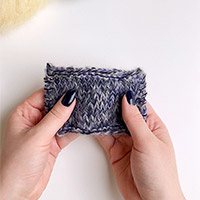
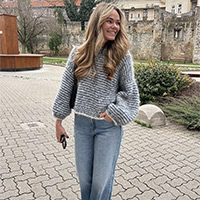


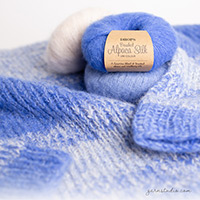

Comments / Questions (21)
I like the look of this pretty sweater!
04.04.2024 - 19:04Having trouble with the sleeves at the point where it says bind off 2 on each side until piece measures 57cm. Do you do this once, then continue or every row until piece measures 57cm?
23.06.2021 - 03:28DROPS Design answered:
Dear Mrs Wrack, you cast off 2 stitches at the beginning of each row (both from RS and from WS) until sleeve measures 57 cm - make sure you have cast off the same number of times 2 sts on each side to get a symetrical sleeve cap. Happy knitting!
23.06.2021 - 08:00Bij het breien van de mouwen kom ik toch echt een probleem tegen. Voor maat S zet ik 56 steken op, na het patroon breien moet ik weerzijde van de markeerdraad 18x1 st, meerderen = volgens mij 38 steken. Wanneer ik die optel bij mijn 56 begin steken kom ik op 92 st. en geen 72. De meerderingen moeten in mijn geval om de 4 cm maar dan kom ik niet uit op de 50 cm die ik dan moet hebben voor de armsgat mindering. Graag uw advies hierin. Vriendelijke groet Els
27.02.2021 - 12:18DROPS Design answered:
Dag Els,
Er lijkt inderdaad een fout in te staan en volgens mij moet het 8 keer voor maat S zijn, in plaats van 18 keer.
02.03.2021 - 10:06Bij het breien van de mouwen kom ik toch echt een probleem tegen. Voor maat S zet ik 56 steken op, na het patroon breien moet ik weerzijde van de markeerdraad 18x1 st, meerderen = volgens mij 38 steken. Wanneer ik die optel bij mijn 56 begin steken kom ik op 92 st. en geen 72. De meerderingen moeten in mijn geval om de 4 cm maar dan kom ik niet uit op de 50 cm die ik dan moet hebben voor de armsgat mindering. Graag uw advies hierin. Vriendelijke groet Els
22.02.2021 - 21:32Thank you for your response but can you explain about the '6 bind offs' on the right front and '6 bind offs' from the left front totaling 12 bind offs? That would only leave 66 stitches for the back and not 80. Right?
15.12.2020 - 21:05DROPS Design answered:
Dear Elaine, you bind off 6 stitches between front pieces and back piece for armhole, then you finish each piece together: front pieces = 54 sts and you bind off 3 sts 1 time + 2 sts 1 time + 1 st 2 time for armhole = 7 sts for armhole. On back piece, there are 94 sts and you bind off 7 sts on each side for armhole = 94-14= 80 sts remain. But when dividing you should have: 54 sts front piece, bind off 6, 94 sts back piece, bind off 6, 54 sts front piece. Happy knitting!
16.12.2020 - 06:55Back for Medium size: When splitting each side and back, the directions say 'knit 54, bind off 6, knit 94, bind off 6, knit 54. If there are 54 stitches on each side and 12 bind offs, that only leaves 80 stitches for the back. When working the back it says to shape armhole that would leave 66 sts not 80. Is that correct? Left side: 54 stitches Right side; 54 stitches Two Bind offs: 12 Back: 80 stitches Total: 200 stitches
11.12.2020 - 21:16DROPS Design answered:
Dear Mrs Peterson, when dividing piece on armholes, you will have (2nd size): 54 sts for each front piece and 94 sts for back piece. You then have to shape armhole casting off 3 sts 1 time, 2 sts 1 time and 1 st 2 times = 7 sts in total are cast off on each front piece, but 14 sts will be cast off for back piece (= you cast off on each side for the armholes) = 80 sts remain after all cast off for armholes are done). Happy knitting!
14.12.2020 - 07:24Ce modele se tricote t-il en un seul morceau pour le corps du gilet ? svp
25.01.2019 - 08:04DROPS Design answered:
Bonjour Véronique, le dos et les deux devants se tricotent en une seule pièce jusqu'aux emmanchures, puis on termine chaque pièce séparément (devant gauche, devant droit et dos). Bon tricot!
25.01.2019 - 09:28No entiendo el final de las instrucciones para la espalda:"Con 47-49-51-53-55 cm, tejer en resorte sobre los 40 pts centrales: 3r, * 2d, 2r *, repetir de *a*, terminar con 2d, 3r (tejer los restantes en pt jersey). " Haciéndolo así, supongo que quedará como cenefa a rayas.¿No se trataría más bien de hacer 3 vueltas (hileras) al revés, dos vueltas al derecho y 2 al revés para seguir el dibujo de la cenefa del cuerpo? El resto (los 7 p restantes) tampoco lo entiendo.
19.08.2018 - 11:45DROPS Design answered:
Hola Teresa, el patrón es correcto, los 40 puntos centrales que se trabajan en punto elástico forman la cenefa del escote en la parte de la espalda, que se trabaja en punto elástico. Después de cerrar los 26 puntos centrales de estos 40, continuamos con 7 puntos a cada lado, trabajándolos a punto elástico para la cenefa del escote.
26.08.2018 - 16:25Ik heb een vraag over de omslag.Hoe moet de omslag tussen een rechte en averechte steek? En tussen een averechte en rechte steek? Ik brei nu door zonder de draad onder de naald naar voor resp. achter te brengen, maar dan worden de gaatjes niet even groot.
01.04.2018 - 07:05DROPS Design answered:
Hoi Gertruud, Als je een omslag maakt tussen een rechte en averechte steek dan breng je eerst de draad naar voren en daarna maak je nog een omslag. Andersom doe je dat ook zo: Eerst de draad naar achteren brengen en dan (indezefde richting) nog een omslag maken.
02.04.2018 - 10:17In de laatste alinea van de brei instructies voor de mouwen wordt geschreven: "kant vervolgens 2 st af aan weerskanten tot een hoogte van 57 cm en vervolgens nog 1 x 3 st. Het werk heeft een hoogte van ca. 58 cm, kant de resterende st af." Is het de bedoeling dat ik eenmalig 2 steken afkant? En daarna nog eenmalig 3 steken. Ik heb namelijk al ongeveer een hoogte van 57 cm bereikt door een keer 2 steken af te kanten. Heel graag een antwoord. De rest van het patroon is heel duidelijk
24.02.2015 - 12:21DROPS Design answered:
Hoi Veronique. Je kant 2 st af aan beide zijkanten tot de mouw een hoogte heeft van 57 cm = dus je blijft 2 st afkanten tot die hoogte. Ben je na 1 keer 2 st afkanten op 57 cm, dan is dat goed. Daarna kant je een keer 3 st af aan beide kanten.
24.02.2015 - 15:53